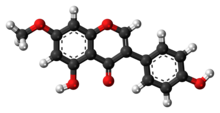Prunetin
Appearance

| |

| |
| Names | |
|---|---|
| IUPAC name
4′,5-Dihydroxy-7-methoxyisoflavone
| |
| Systematic IUPAC name
5-Hydroxy-3-(4-hydroxyphenyl)-7-methoxy-4H-1-benzopyran-4-one | |
| Other names
Prunusetin
5,4'-dihydroxy-7-methoxyisoflavone | |
| Identifiers | |
3D model (JSmol)
|
|
| ChEBI | |
| ChEMBL | |
| ChemSpider | |
| ECHA InfoCard | 100.008.199 |
| EC Number |
|
| KEGG | |
PubChem CID
|
|
| UNII | |
CompTox Dashboard (EPA)
|
|
| |
| |
| Properties | |
| C16H12O5 | |
| Molar mass | 284.26 g/mol |
Except where otherwise noted, data are given for materials in their standard state (at 25 °C [77 °F], 100 kPa).
| |
Prunetin is an O-methylated isoflavone, a type of flavonoid. It has been isolated for the first time by Finnemore in 1910 in the bark of Prunus emarginata (the Oregon cherry).[1] Prunetin isolated from pea roots can act as an attractant for Aphanomyces euteiches zoospores.[2] It is also an allosteric inhibitor of human liver aldehyde dehydrogenase.[3]
Prunetin can lower blood pressure of spontaneously hypertensive rats and relax isolated rat aortic rings through calcium channel block mechanisms in vessel smooth muscles.[4]
Glycosides
[edit]- 8-C-glucosyl prunetin, isolated from the leaves of Dalbergia hainanensis[5]
See also
[edit]References
[edit]- ^ Shriner, R. L.; Hull, Clarence J. (1945). "Isoflavones. III. The Structure of Prunetin and a New Synthesis of Genistein1". The Journal of Organic Chemistry. 10 (4): 288–291. doi:10.1021/jo01180a006.
- ^ Yokosawa, Ryozo; Kuninaga, Shiro; Sekizaki, Harua (1986). "Aphanomyces euteiches zoospore attractant isolated from pea root; prunetin". Ann. Phytopath. Soc. Japan. 52 (5): 809–816. doi:10.3186/jjphytopath.52.809.
- ^ Sheikh, S.; Weiner, H. (1997). "Allosteric inhibition of human liver aldehyde dehydrogenase by the isoflavone prunetin". Biochemical Pharmacology. 53 (4): 471–478. doi:10.1016/s0006-2952(96)00837-4. PMID 9105397.
- ^ Kim, Bumjung; Jo, Cheolmin; Choi, Ho-Young; Lee, Kyungjin (2018). "Prunetin Relaxed Isolated Rat Aortic Rings by Blocking Calcium Channels". Molecules. 23 (9): 2372. doi:10.3390/molecules23092372. PMC 6225200. PMID 30227625.
 This article incorporates text from this source, which is available under the CC BY 4.0 license.
This article incorporates text from this source, which is available under the CC BY 4.0 license.
- ^ Pei Cheng Zhang, Ying Hong Wang, Xin Liu, Xiang Yi, Ruo Yun Chen and De Quan Yu (2002). "Conformational Study of 8-C-glucosyl-prunetin by Dynamic NMR Spectroscopy" (PDF). Chinese Chemical Letters. 13 (7): 645–648. Archived from the original (PDF) on 2011-07-07. Retrieved 2010-02-26.
{{cite journal}}: CS1 maint: multiple names: authors list (link)
